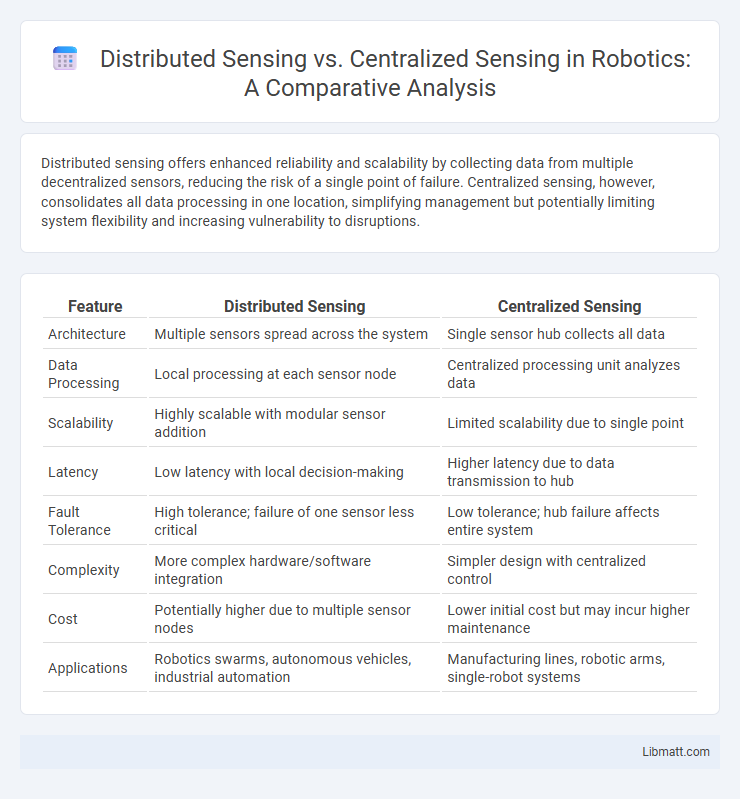Distributed sensing offers enhanced reliability and scalability by collecting data from multiple decentralized sensors, reducing the risk of a single point of failure. Centralized sensing, however, consolidates all data processing in one location, simplifying management but potentially limiting system flexibility and increasing vulnerability to disruptions.
Table of Comparison
| Feature | Distributed Sensing | Centralized Sensing |
|---|---|---|
| Architecture | Multiple sensors spread across the system | Single sensor hub collects all data |
| Data Processing | Local processing at each sensor node | Centralized processing unit analyzes data |
| Scalability | Highly scalable with modular sensor addition | Limited scalability due to single point |
| Latency | Low latency with local decision-making | Higher latency due to data transmission to hub |
| Fault Tolerance | High tolerance; failure of one sensor less critical | Low tolerance; hub failure affects entire system |
| Complexity | More complex hardware/software integration | Simpler design with centralized control |
| Cost | Potentially higher due to multiple sensor nodes | Lower initial cost but may incur higher maintenance |
| Applications | Robotics swarms, autonomous vehicles, industrial automation | Manufacturing lines, robotic arms, single-robot systems |
Introduction to Distributed and Centralized Sensing
Distributed sensing utilizes multiple interconnected sensors spread across various locations to collect real-time data, enhancing spatial resolution and fault tolerance compared to centralized sensing. Centralized sensing relies on a single or limited number of sensors gathering information at a central point, simplifying data management but potentially creating bottlenecks and single points of failure. Choosing between distributed and centralized sensing affects your system's scalability, accuracy, and reliability depending on the specific application requirements.
Key Definitions and Core Concepts
Distributed sensing involves multiple sensors placed across various locations, each collecting and processing data locally to provide real-time insights and increase system resilience. Centralized sensing relies on a single central unit or location where data from all sensors is aggregated and analyzed, offering a comprehensive overview but potentially creating a single point of failure. Key concepts include data locality and fault tolerance in distributed sensing, versus centralized data management and simplified infrastructure in centralized sensing.
Architecture Overview: Distributed vs Centralized Sensing
Distributed sensing architecture employs multiple sensors spread across various locations, enabling localized data collection and processing that enhances system resilience and real-time responsiveness. Centralized sensing relies on a single or few central nodes for data aggregation and analysis, which may simplify management but risks congestion and single points of failure. Your choice between distributed and centralized sensing directly impacts scalability, fault tolerance, and latency in data-driven applications.
Data Collection and Transmission Methods
Distributed sensing collects data locally at multiple sensor nodes, reducing the need for continuous data transmission to a central hub and enabling faster real-time processing. Centralized sensing gathers all data at a single location or central processor, which requires higher bandwidth for transmitting large volumes of data but simplifies system management. Your choice between these methods depends on factors like network scalability, latency requirements, and communication infrastructure.
Scalability and Flexibility Considerations
Distributed sensing systems offer greater scalability by allowing sensors to operate independently across multiple locations, facilitating easy expansion without major infrastructure changes. Centralized sensing tends to have limited flexibility due to reliance on a single processing hub, which can become a bottleneck as more sensors are added. Your choice between distributed and centralized sensing should consider the need for future scalability and adaptability to changing environmental or operational conditions.
Reliability and Fault Tolerance Comparison
Distributed sensing systems offer higher reliability and fault tolerance by decentralizing data collection, enabling continuous operation despite individual sensor failures. Centralized sensing architectures face greater risk of total system failure if the central node or communication link is compromised. Redundancy in distributed sensing networks enhances robustness and ensures consistent performance in dynamic or harsh environments.
Real-Time Performance and Latency
Distributed sensing systems offer superior real-time performance by processing data locally at multiple sensor nodes, significantly reducing latency compared to centralized sensing architectures that rely on transmitting raw data to a central processor. This localized data processing minimizes communication delays and bandwidth bottlenecks, enabling faster response times essential for applications such as autonomous vehicles and industrial automation. Centralized sensing, while simpler to manage, often suffers from higher latency due to data aggregation and transmission overhead, limiting its effectiveness in time-critical scenarios.
Security and Privacy Implications
Distributed sensing enhances security by decentralizing data collection, reducing the risk of single points of failure and making it harder for attackers to compromise the entire system. Centralized sensing, while easier to manage, concentrates sensitive information in one location, increasing vulnerability to data breaches and privacy attacks. Your choice between distributed and centralized sensing should consider the balance between operational control and the potential exposure of critical data.
Application Areas for Distributed and Centralized Sensing
Distributed sensing dominates in large-scale infrastructure monitoring, such as smart grids, environmental sensing, and structural health monitoring of bridges and pipelines, where real-time data collection from numerous points is critical. Centralized sensing is preferred in controlled environments like industrial automation and security systems, offering precise data aggregation and easier management in factory floors and surveillance setups. Both sensing methods play key roles in smart city development, balancing the need for widespread data acquisition and centralized data processing.
Choosing the Right Sensing Approach for Your Needs
Distributed sensing offers enhanced spatial coverage and real-time data collection across extensive areas, making it ideal for environments requiring detailed, localized monitoring such as structural health and environmental applications. Centralized sensing consolidates data processing at a single node, providing simplified system management and reduced data redundancy, which suits applications with limited sensor networks and centralized control like manufacturing processes. Selecting between distributed and centralized sensing depends on factors such as scale, data latency requirements, system complexity, and budget constraints to ensure optimal performance and cost-effectiveness.
Distributed sensing vs Centralized sensing Infographic

 libmatt.com
libmatt.com